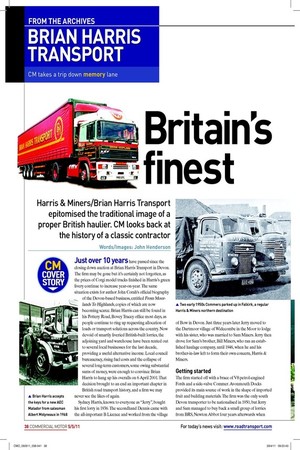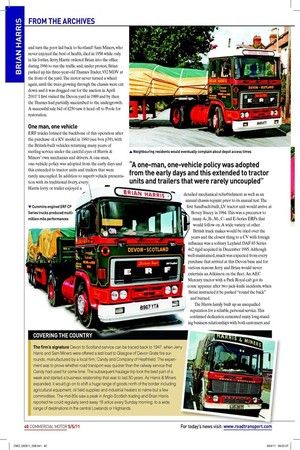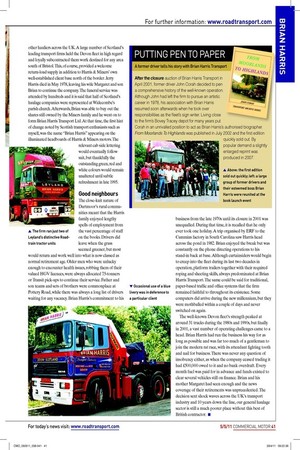Britain’s finest
Page 33

Page 34

Page 35

Page 36

If you've noticed an error in this article please click here to report it so we can fix it.
Harris & Miners/Brian Harris Transport epitomised the traditional image of a proper British haulier. CM looks back at the history of a classic contractor
Words/Images: John Henderson Just over 10 years have passed since the closing down auction at Brian Harris Transport in Devon. The irm may be gone but it’s certainly not forgotten, as the prices of Corgi model trucks inished in Harris’s green livery continue to increase year-on-year. The same situation exists for author John Corah’s oficial biography of the Devon-based business, entitled From Moorlands To Highlands, copies of which are now becoming scarce. Brian Harris can still be found in his Pottery Road, Bovey Tracey ofice most days, as people continue to ring up requesting allocation of loads or transport solutions across the country. Now devoid of smartly liveried British-built lorries, the adjoining yard and warehouse have been rented out to several local businesses for the last decade, providing a useful alternative income. Local council bureaucracy, rising fuel costs and the collapse of several long-term customers, some owing substantial sums of money, were enough to convince Brian Harris to hang up his overalls on 6 April 2001. That decision brought to an end an important chapter in British road transport history, and a irm we may never see the likes of again.
Sydney Harris, known to everyone as “Jerry” , bought his irst lorry in 1936. The secondhand Dennis came with the all-important B Licence and worked from the village of Bow in Devon. Just three years later Jerry moved to the Dartmoor village of Widecombe in the Moor to lodge with his sister, who was married to Sam Miners. Jerry then drove for Sam’s brother, Bill Miners, who ran an established haulage company, until 1946, when he and his brother-in-law left to form their own concern, Harris & Miners.
Getting started
The irm started off with a brace of V8 petrol-engined Fords and a side-valve Commer. Avonmouth Docks provided its main source of work in the shape of imported fruit and building materials. The irm was the only south Devon transporter to be nationalised in 1950, but Jerry and Sam managed to buy back a small group of lorries from BRS, Newton Abbot four years afterwards when denationalisation inally dawned.
Anyone who has visited Wide combe in the Moor would think it an unlikely place from which to run a haulage operation, but the purchase of some land in 1957 in Bovey Tracey saw the irm gradually relocate to a site much more convenient for the main A38 road. Jerry Harris had married local girl Margaret Nosworthy in 1942 and the pair would live out the rest of their lives in Widecombe. The administration work for the business was always carried out in the village right up until its last day of operation in 2001. Brian Harris was born in 1943 and joined his father straight from school at 15 years of age. He would be promoted on to longdistance work just two years later, driving an Albion Chieftain that weighed in at a shade below three tons [sic] unladen. Harris & Miners ran a mixed leet of British marques during its early years, with mainstay motors from the Albion Commer and Dodge stables interspersed with some AECs, Maudslays and Leylands. Traditional moorland leet names such as Bill Brewer, Jan Stewer and Uncle Tom Cobley were used throughout the irm’s history, long before some of today’s better-known leets that carry monikers admired by legions of lorry spotters.
Growing pains
Harris & Miners’ signature Devon to Scotland service (see box p40) let the leet expand steadily throughout the 1950s and 1960s. Occasionally, in the early part of these busy decades, there was no time for painting or sign writing, and plain-coloured lorries were sent up the road immediately after purchase. Jerry Harris was still driving in those days, but preferred not to stray too far and keep a tight rein on the business. Changeovers were the bane of drivers’ lives, then as now, when a northbound Jerry, heading through Devon or Somerset, would often lag down one of his men returning home after a week away and turn the poor lad back to Scotland! Sam Miners, who never enjoyed the best of health, died in 1958 while only in his forties. Jerry Harris ordered Brian into the ofice during 1966 to run the trafic and, under protest, Brian parked up his three-year-old Thames Trader, 932 MDV at the front of the yard. The motor never turned a wheel again, until the trees growing through the chassis were cut down and it was dragged out for the auction in April 2001! I irst visited the Devon yard in 1989 and by then the Thames had partially succumbed to the undergrowth. A successful sale bid of £250 saw it head off to Poole for restoration.
One man, one vehicle
ERF trucks formed the backbone of this operation after the purchase of a KV model in 1960 (see box p39), with the British-built vehicles returning many years of sterling service under the careful eyes of Harris & Miners’ own mechanics and drivers. A one-man, one-vehicle policy was adopted from the early days and this extended to tractor units and trailers that were rarely uncoupled. In addition to superb vehicle presentation with its traditional livery, every Harris lorry or trailer enjoyed a detailed mechanical refurbishment as well as an annual chassis repaint prior to its annual test. The irst Sandbach-built, LV tractor unit would arrive at Bovey Tracey in 1964. This was a precursor to many A-, B-, M-, Cand E-Series ERFs that would follow on. A wide variety of other British truck makes would be tried over the years and the closest thing to a CV with foreign inluence was a solitary Leyland DAF 65 Series 4x2 rigid acquired in December 1995. Although well-maintained, much was expected from every purchase that arrived at this Devon base and for various reasons Jerry and Brian would never entertain an Atkinson on the leet. An AEC Mercury tractor with a Park Royal cab got its come uppance after two jack-knife incidents, when Brian instructed it be parked “round the back” and burned.
The Harris family built up an unequalled reputation for a reliable, personal service. This continued dedication cemented many long-standing business relationships with both customers and other hauliers across the UK. A large number of Scotland’s leading transport irms held the Devon leet in high regard and loyally subcontracted them work destined for any area south of Bristol. This, of course, provided a welcome return-load supply in addition to Harris & Miners’ own well-established client base north of the border. Jerry Harris died in May 1978, leaving his wife Margaret and son Brian to continue the company. The funeral service was attended by hundreds and it is said that half of Scotland’s haulage companies were represented at Widecombe’s parish church. Afterwards, Brian was able to buy out the shares still owned by the Miners family and he went on to form Brian Harris Transport Ltd. At that time, the irst hint of change noted by Scottish transport enthusiasts such as myself, was the name “Brian Harris” appearing on the illuminated headboards of Harris & Miners motors. The relevant cab side lettering would eventually follow suit, but thankfully the outstanding green, red and white colours would remain unaltered until subtle refreshment in late 1995.
Good neighbours
The close-knit nature of Dartmoor’s rural communities meant that the Harris family enjoyed lengthy spells of employment from
▲ The firm ran just two of the vast percentage of staff Leyland’s distinctive Roadon the books. Drivers did train tractor units leave when the grass
seemed greener, but most would return and work well into what is now classed as normal retirement age. Older men who were unlucky enough to encounter health issues, robbing them of their valued HGV licences, were always allocated 7.5-tonners or Transit pick-ups to continue their service. Father and son teams and sets of brothers were commonplace at Pottery Road, while there was always a long list of drivers waiting for any vacancy. Brian Harris’s commitment to his business from the late 1970s until its closure in 2001 was unequalled. During that time, it is recalled that he only ever took one holiday. A trip organised by ERF to the Cummins factory in South Carolina saw Harris head across the pond in 1982. Brian enjoyed the break but was constantly on the phone directing operations to his stand-in back at base. Although curtainsiders would begin to creep into the leet during its last two decades in operation, platform trailers together with their required roping and sheeting skills, always predominated at Brian Harris Transport. The same could be said for traditional, paper-based trafic and ofice systems that the irm remained faithful to throughout its existence. Some computers did arrive during the new millennium, but they were mothballed within a couple of days and never switched on again.
The well-known Devon leet’s strength peaked at around 31 trucks during the 1980s and 1990s, but inally in 2001, a vast number of operating challenges came to a head. Brian Harris had run the business his way for as long as possible and was far too much of a gentleman to join the modern rat race, with its attendant ighting tooth and nail for business. There was never any question of insolvency either, as when the company ceased trading it had £500,000 owed to it and no bank overdraft. Every month fuel was paid for in advance and funds existed to clear several vehicles still on inance. Brian and his mother Margaret had seen enough and the news coverage of their retirements was unprecedented. The decision sent shock waves across the UK’s transport industry and 10 years down the line, our general haulage sector is still a much poorer place without this best of British contractor. ■
















































